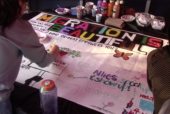People with disabilities often need assistance finding specialized therapies, housing, employment, training for independent living or with specialized equipment like wheelchairs.
Under California law, the agencies that provide these services are called regional centers.
However, critics say regional centers continue to underserve people of color, even after millions in state spending meant to correct racial gaps plaguing the system.
A report by the legal advocacy group Public Counsel found that, in 15 of the 19 regional centers across the state, Asian and Latino citizens are more likely to receive no services. Measured by dollars, regional centers also spend less on services for Asian and Latino clients — about 68 cents for every dollar they spend on white clients, Public Counsel found.
“You can just look within the four walls of one regional center. There is a startling difference between Whites, African Americans, Asians and Latinos,” said Brian Capra, a senior staff attorney with Public Counsel’s Children’s Rights Project.
“It’s no secret that there are racial and ethnic disparities in regional centers,” said Nina Spiegelman, director of Policy at the advocacy organization Disability Voices United. “Unless you go to each regional center, one by one, it’s hard to get a sense of what’s really going on.”
Each of California’s 21 regional centers oversee services within a geographic territory — and the racial disparities vary in each of these regions. The regional center serving central Los Angeles, Hollywood, Glendale and Pasadena spent $8,561 less on the average Latino client — the biggest gap in the state, according to the L.A. Times.
In its own report, Disability Voices United expanded on the Public Counsel’s findings by adding adults into the equation.
Average spending on adults across regional centers ranges from a high of $60,347 per client at Golden Gate in San Francisco to a low of $26,409 at Inland Regional Center in San Bernardino.
from the state’s Department of Developmental Disability Services issued $22 million in grant funding meant to substantially reduce shortfalls in spending on Latinos at regional centers.
However, Disability Voices United has found that no regional center successfully utilized the grant money. In fact, according to the Disability Voices United report, after 5 years of the grants being in place, the majority of regional centers saw more than a 50% increase in the gap between Whites and Latinos.
The report also outlines recommendations that these agencies can make to address these issues. They include understanding a person’s identity and culture, creating an ongoing satisfaction survey for the Department of Developmental Disability Services, investigating allegations of mistreatment and increased public access to data about the racial disparities in services.
In a statement to the L.A. Times, the state’s Department of Disability Services acknowledged the disparities and said that while officials have attempted to address them, “there still is much room for improvement.”
This show was produced by Lupita Baltazar, Justin Borses and Sade Pullen

 Tweet this Video
Tweet this Video Share on Facebook
Share on Facebook Share via E-mail
Share via E-mail

